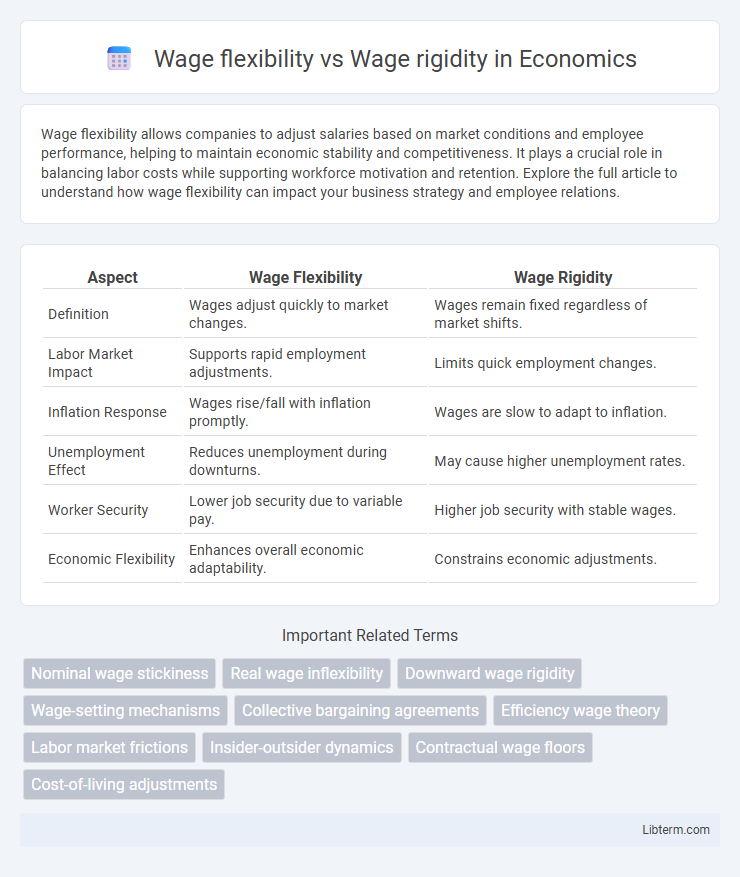Wage flexibility allows companies to adjust salaries based on market conditions and employee performance, helping to maintain economic stability and competitiveness. It plays a crucial role in balancing labor costs while supporting workforce motivation and retention. Explore the full article to understand how wage flexibility can impact your business strategy and employee relations.
Table of Comparison
| Aspect | Wage Flexibility | Wage Rigidity |
|---|---|---|
| Definition | Wages adjust quickly to market changes. | Wages remain fixed regardless of market shifts. |
| Labor Market Impact | Supports rapid employment adjustments. | Limits quick employment changes. |
| Inflation Response | Wages rise/fall with inflation promptly. | Wages are slow to adapt to inflation. |
| Unemployment Effect | Reduces unemployment during downturns. | May cause higher unemployment rates. |
| Worker Security | Lower job security due to variable pay. | Higher job security with stable wages. |
| Economic Flexibility | Enhances overall economic adaptability. | Constrains economic adjustments. |
Understanding Wage Flexibility and Wage Rigidity
Wage flexibility refers to the ability of wages to adjust quickly in response to changes in labor market conditions, enabling employers to modify compensation based on supply and demand. Wage rigidity occurs when wages remain fixed or slow to change due to factors such as minimum wage laws, long-term contracts, or social norms, often leading to unemployment or labor market inefficiencies. Understanding these concepts is crucial for analyzing how labor markets respond to economic fluctuations and policy interventions.
Key Differences Between Wage Flexibility and Rigidity
Wage flexibility refers to the ability of wages to adjust swiftly in response to labor market conditions, economic fluctuations, or productivity changes, promoting efficient allocation of labor resources. Wage rigidity, in contrast, involves fixed or sticky wages that resist downward or upward adjustments, often due to contracts, minimum wage laws, or social norms, which can lead to unemployment or reduced labor market efficiency. The key difference lies in how each impacts labor market equilibrium: flexible wages facilitate quick adaptation and balance, while rigid wages may cause imbalances like persistent unemployment or labor shortages.
Economic Impacts of Wage Flexibility
Wage flexibility allows labor markets to adjust efficiently to economic shocks, reducing unemployment and promoting faster recovery during recessions. Flexible wages enable businesses to align labor costs with current demand, enhancing competitiveness and productivity growth. Empirical studies demonstrate that economies with higher wage flexibility experience lower duration of unemployment and improved labor market equilibrium.
Consequences of Wage Rigidity in Labor Markets
Wage rigidity limits employers' ability to adjust wages in response to economic fluctuations, leading to prolonged unemployment during economic downturns and reduced labor market efficiency. It can result in a mismatch between labor supply and demand, causing firms to delay hiring or resort to layoffs instead of wage adjustments. Persistent wage rigidity often hampers economic recovery and exacerbates structural unemployment, especially in tightly regulated labor markets.
Wage Flexibility During Economic Crises
Wage flexibility during economic crises enables firms to adjust labor costs quickly in response to demand shocks, helping to mitigate unemployment and maintain economic stability. Flexible wages allow for reductions in nominal wages or shifts toward performance-based pay, which can prevent drastic layoffs and support recovery. Empirical studies show that countries with higher wage flexibility experience shorter recessions and faster employment rebounds compared to those with rigid wage structures.
The Role of Wage Rigidity in Protecting Workers
Wage rigidity plays a critical role in protecting workers by preventing sudden wage cuts during economic downturns, thereby maintaining stable income levels and reducing financial stress. This rigidity helps preserve worker morale and productivity by ensuring predictable earnings, which in turn supports consumer spending and overall economic stability. However, while wage flexibility allows firms to adjust labor costs quickly, wage rigidity acts as a social safety mechanism that cushions workers from volatility in labor markets.
Influencing Factors: What Drives Wage Flexibility or Rigidity?
Wage flexibility or rigidity is influenced by labor market conditions, union power, and institutional frameworks such as minimum wage laws and employment protection regulations. Economic shocks and inflation expectations also drive firms' willingness to adjust wages, while long-term contracts and social norms promote wage rigidity. Technological changes and productivity growth can increase wage flexibility by enabling differential pay adjustments based on performance and skills.
Policy Approaches: Promoting Flexibility or Ensuring Rigidity
Policy approaches to wage flexibility emphasize dynamic labor markets, advocating for adaptable wage structures that respond to economic fluctuations and productivity changes to enhance employment and competitiveness. Conversely, policies ensuring wage rigidity focus on protecting worker incomes through minimum wage laws, collective bargaining, and labor regulations to maintain social stability and reduce inequality. Balancing these approaches involves designing frameworks that promote wage adaptability while safeguarding essential worker protections to achieve sustainable economic growth and social equity.
Global Examples: Wage Flexibility vs Rigidity in Practice
Wage flexibility allows labor markets to adjust swiftly to economic fluctuations, evident in countries like the United States, where variable pay and bonuses respond to performance and market conditions. In contrast, wage rigidity, common in European nations such as France and Germany, results from strong labor unions and collective bargaining agreements that maintain stable wages despite economic downturns. Emerging economies like Brazil experience mixed wage dynamics, with formal sectors exhibiting rigidity due to regulations, while informal sectors display more flexibility.
The Future of Wages: Trends Toward Flexibility or Rigidity
Wage flexibility is increasingly driven by technological advancements and organizational shifts toward gig economies, enabling adaptive compensation aligned with market demands. Conversely, wage rigidity persists in sectors with strong labor unions and regulatory frameworks that prioritize wage stability to protect workers' income. Future wage trends reflect a dynamic interplay between flexible pay structures fostering innovation and rigid wages securing employee welfare in uncertain economic landscapes.
Wage flexibility Infographic

 libterm.com
libterm.com